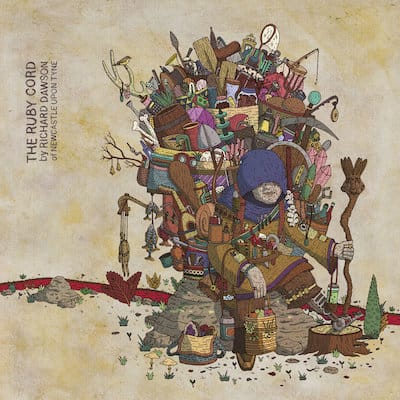Richard Dawson
The Ruby Cord
Weird World
18 November 2022

Take either of Richard Dawson’s previous two solo albums and examine them in isolation, and you could make a case for him being our greatest living songwriter. Peasant (2017) examined the lives of a diverse but linked set of characters in Anglo-Saxon Britain, while 2020 (2019) saw Dawson cast his eye over contemporary issues ranging from racism to parenthood via social anxiety, climate change, poor working conditions and football. Where both of these albums succeeded was in the richness and variety of their storytelling combined with Dawson’s inimitable singing and musicianship. It always felt that those two albums were in some way linked, in spite of the gulf of centuries that lay between their respective subjects, and with the release of The Ruby Cord – effectively the third album of a trilogy – that has proved to be the case.
Where Peasant and 2020 dealt with the past and present, The Ruby Cord is set in a future, a dystopian world finding its feet after a complete societal collapse. Dawson’s new world is part pagan folk horror, part glitch-ridden sci-fi. The very fabric of life seems to have taken on a hallucinatory warp, something that Dawson makes expressly clear in the sheer unadulterated strangeness of the album’s opening track, The Hermit. All forty-one minutes of it. The length alone gives you some clue that this is the most frighteningly ambitious thing he has ever tried. But go beyond the daunting numbers, and you will find a song that is haunting, beautiful and earthy. It is like Richard Jefferies’ proto-sci-fi novel After London, reimagined by Northumberland modernist poet Basil Bunting. The level of detail, the affinity with the natural world and the almost preposterous juxtapositions mark Dawson’s poetic voice out as something utterly unique. It’s impossible to explain exactly what goes on in the song in the space of an album review, but it is worth noting that the song is haunted by a godly Ada (presumably Ada Lovelace) and her slippers, as well as the future and past lives of fungi, a medieval knight/robot hybrid and an astonishing array of animal and bird life.
All the more remarkable is how the whole of The Hermit falls together with something that hints at structure. It might be longer than the first half of a rugby match, but it feels like a song, and part of that is down to Dawson’s innate – if highly unusual – sense of melody, which finds release in the song’s lengthy and plaintive coda, sung by a motley mix of guests.
That the rest of the album manages to emerge from the huge shadow of its opening track is a feat in itself. Thicker Than Water, with Rhodri Davies’ harp flourishes and Andrew Cheetham’s mellow percussion, comes on like a hauntological Joanna Newsom. The lyrics speak of family ties, grief, and the difficulties of communication, all the while maintaining the painstakingly constructed future world. The Fool goes harder, with industrial synth stabs and gurgles underpinning Dawson’s take on forbidden love, set in a landscape straight out of a Bosch painting. It bears some of the hallmarks of producer Sam Grant (Pigs Pigs Pigs Pigs Pigs Pigs Pigs), who has worked with Dawson on all three albums of the trilogy.
The Museum, told from the point of view of a curator of the history of a human civilisation long-disappeared, has some of the album’s simplest but most touching moments. The narrator recounts a list of distant memories preserved for posterity, including an image, both heartbreaking and ironic, of ‘riot police beating climate protestors’. The Tip Of An Arrow navigates from gentle harp via wobbly synths to a metal-influenced section that perhaps owes something to Dawson’s recent collaboration with Finnish experimental rockers Circle. It also manages to talk about parenthood, the value of work and the acquisition of wisdom in a way that marries the language and lore of Anglo-Saxon Britain with Aristotelian philosophy.
After a brief and windswept instrumental, the album ends with Horse And Rider, a flight into the wild ushered in on Angharad Davies’ sweet and folky violin and bringing with it a freshening blast of optimism and outdoor air with a tune that wouldn’t feel out of place on a Richard Thompson album. It encapsulates a fundamental truth of the album, the trilogy and all of Richard Dawson’s work: for all the care and the worry, there is always the possibility of an upsurge of joy, a moment of release. Wherever he currently sits on his 1000-year timeline, Dawson always speaks with unparalleled eloquence and imagination about the concerns and the comforts we all face.
The Ruby Cord will be available to preorder on Dom Mart-exclusive double red vinyl with print, indies-exclusive double blue vinyl with print, standard double vinyl, CD and digitally. Preorder: Dom Mart | Digital
Also via Bandcamp


